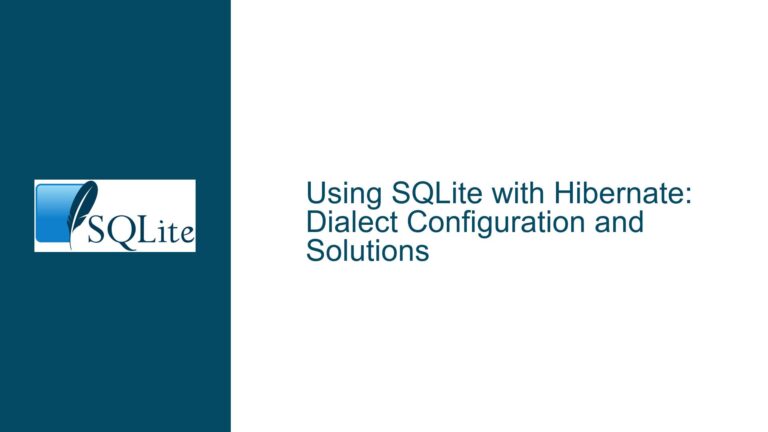Implementing Reactive Queries in SQLite: Performance Challenges and Solutions
Reactive Query Subscription Mechanisms and Their Impact on SQLite Performance
The concept of reactive query subscriptions involves creating a system where applications automatically receive notifications when data matching specific criteria changes. This is critical for modern UI-driven applications that require real-time updates without manual refreshes. In SQLite, the challenge lies in balancing the granularity of change detection with the computational overhead of re-evaluating queries. Traditional approaches, such as using SQLite’s update_hook, work for small datasets but fail to scale efficiently. When queries involve multiple tables, complex joins, or sub-selects, the cost of re-running them after every write operation becomes prohibitive. This is exacerbated in environments with strict timing constraints (e.g., browser-based WASM builds with 16ms frame budgets), where excessive query re-execution can degrade user experience.
The problem is further complicated by the need to distinguish between insertions, updates, and deletions that affect query results. For example, a query like SELECT * FROM posts WHERE owner_id = ? AND modified_time > ? AND category = ? must trigger callbacks not only when new rows are inserted but also when existing rows are modified to either match or no longer match the criteria. Existing solutions that rely on table-level notifications (e.g., update_hook) lack the precision to avoid unnecessary query re-execution. This leads to redundant computation, especially when writes affect tables tangentially related to active queries. The absence of native support for row-level or predicate-based notifications forces developers to implement workarounds that introduce latency and complexity.
Limitations of SQLite’s Native Hooks and Event Propagation
1. Coarse-Grained Notifications via update_hook
SQLite’s update_hook provides notifications at the table level, not the row or predicate level. When a table is modified, all queries referencing that table must be re-evaluated, regardless of whether the modification affects their result sets. For example, if a query filters rows where category = 'news', but a write operation updates a row with category = 'sports', the update_hook still forces the query to re-run. This results in wasted CPU cycles and increased latency, particularly when dealing with large datasets or complex joins.
2. Lack of Incremental Result Set Tracking
SQLite does not natively track which rows belong to a query’s result set over time. Without this capability, developers must re-execute the entire query after any relevant table modification to determine what changed. This is inefficient for queries that return large result sets or involve aggregations. For instance, a query calculating COUNT(*) for a filtered subset would need to re-scan the entire dataset after each write, even if only one row was added or removed.
3. Concurrency Constraints in WASM Environments
In browser-based WASM builds, SQLite operates in a single-threaded environment where concurrent reads and writes are not possible. This eliminates the option of offloading query re-execution to background threads, forcing all computation to occur on the main thread. As a result, frequent query re-execution can block UI rendering, violating the 16ms frame budget required for smooth animations.
4. Absence of Built-In Predicate Indexing
A "reverse database" that indexes active queries’ predicates (e.g., owner_id = ?, modified_time > ?) does not exist in SQLite. Such an index would allow the database to quickly determine which queries are affected by a write operation based on the values being modified. Without this, developers must manually maintain metadata about active queries and their constraints, leading to increased complexity and potential for errors.
Strategies for Efficient Reactive Query Handling in SQLite
1. Predicate-Based Reverse Indexing System
Concept:
Build an external index that maps query predicates to their corresponding subscriptions. For example, store ranges or hash-based representations of constraints like owner_id = 5 or modified_time > 1625097600. When a write occurs, check the modified values against these indexes to determine which subscriptions require notification.
Implementation Steps:
- Parse Query Constraints: Use SQLite’s
sqlite3_stmtinterface or theEXPLAINcommand to extract predicates from queries. For the querySELECT * FROM posts WHERE owner_id = ? AND modified_time > ? AND category = ?, extract the columns (owner_id,modified_time,category) and their constraints. - Index Predicates: Store these constraints in a secondary table or in-memory structure. For range queries, use interval trees or bitmap indexes. For equality checks, use hash maps.
- Hook into Write Operations: Extend SQLite’s
update_hookto capture the old and new values of modified rows. Compare these values against the predicate index to identify affected subscriptions. - Trigger Callbacks: For matching subscriptions, invoke application-specific callbacks with the relevant row data instead of re-executing the entire query.
Example:
-- Predicate index table
CREATE TABLE predicate_index (
query_id INTEGER PRIMARY KEY,
table_name TEXT,
column_name TEXT,
operator TEXT CHECK(operator IN ('=', '>', '<', '>=', '<=')),
value BLOB
);
-- During a write to 'posts', check predicates:
SELECT query_id FROM predicate_index
WHERE table_name = 'posts'
AND column_name = 'owner_id'
AND (operator = '=' AND value = NEW.owner_id)
OR (operator = '>' AND NEW.owner_id > value);
Advantages:
- Reduces unnecessary query re-execution by filtering notifications at the predicate level.
- Scales linearly with the number of active predicates rather than the number of queries.
Challenges:
- Handling compound predicates (e.g.,
AND/ORcombinations) requires combinatorial checks. - Dynamic parameters (e.g.,
?placeholders) complicate predicate indexing unless bound values are tracked.
2. Session Extension for Change Tracking
Concept:
Leverage SQLite’s session extension to capture changesets at the table level. These changesets can be analyzed to determine their impact on active queries.
Implementation Steps:
- Enable Sessions: Attach a session object to each table monitored by reactive queries.
- Capture Changes: After a transaction commits, extract the changeset containing old and new row values.
- Diff Analysis: Compare the changeset against active queries’ predicates to identify overlaps. For example, if a changeset modifies a row’s
categoryfromnewstosports, check if any queries includecategory = 'sports'. - Partial Query Re-execution: For affected queries, re-run only the portions of the query impacted by the changeset (e.g., using
WITH CHANGESETCTEs).
Example:
// C API example for capturing changesets
sqlite3session *pSession;
sqlite3session_create(db, "posts", &pSession);
sqlite3session_attach(pSession, "posts");
// After a transaction:
sqlite3session_changeset(pSession, &nChangeset, &pChangeset);
// Analyze pChangeset for predicate overlaps
Advantages:
- Built-in mechanism for capturing granular table changes.
- Changesets can be serialized and reused for replication or undo/redo functionality.
Challenges:
- Changeset analysis requires custom logic to map row-level changes to query predicates.
- Overhead increases with the number of tracked tables and the frequency of writes.
3. Materialized Views with Incremental Maintenance
Concept:
Create materialized views that cache query results and incrementally update them based on write operations. This approach is inspired by databases like Materialize and ReadySet, which specialize in low-latency view updates.
Implementation Steps:
- Create Shadow Tables: For each reactive query, create a shadow table that stores the current result set.
- Triggers for Incremental Updates: Attach triggers to base tables that update the shadow table on INSERT/UPDATE/DELETE. For example, after inserting a row into
posts, determine if it matches the query’s WHERE clause and add it to the shadow table. - Query the Shadow Table: Direct the UI to read from the shadow table instead of the base tables.
Example:
-- Shadow table for the posts query
CREATE TABLE shadow_posts_query1 AS
SELECT * FROM posts WHERE owner_id = 5 AND modified_time > 1625097600 AND category = 'news';
-- Trigger on posts INSERT
CREATE TRIGGER posts_after_insert AFTER INSERT ON posts
BEGIN
INSERT INTO shadow_posts_query1
SELECT NEW.* WHERE NEW.owner_id = 5 AND NEW.modified_time > 1625097600 AND NEW.category = 'news';
END;
Advantages:
- Eliminates full query re-execution by incrementally updating cached results.
- Shadow tables can be indexed for faster UI rendering.
Challenges:
- Trigger maintenance becomes complex for queries involving joins or subqueries.
- Storage overhead increases with the number of materialized views.
4. WASM-Specific Optimizations
Concept:
Optimize for single-threaded environments by batching write operations and deferring query re-execution to idle periods.
Implementation Steps:
- Debounce Writes: Accumulate write operations in a queue and process them in batches during the next idle period.
- Prioritize Queries: Assign priority levels to queries based on UI criticality. High-priority queries (e.g., visible on screen) are re-executed immediately; others are deferred.
- Virtual Table Caching: Use SQLite’s virtual tables to create in-memory caches of frequently accessed query results.
Example:
// JavaScript example for debouncing writes in WASM
let writeQueue = [];
let isProcessing = false;
function debouncedWrite(operation) {
writeQueue.push(operation);
if (!isProcessing) {
requestIdleCallback(processWrites);
}
}
function processWrites(deadline) {
while (deadline.timeRemaining() > 0 && writeQueue.length > 0) {
const op = writeQueue.shift();
op.execute();
}
isProcessing = false;
}
Advantages:
- Reduces UI thread contention by limiting query re-execution to idle periods.
- Improves perceived performance by prioritizing visible elements.
Challenges:
- Requires careful state management to avoid inconsistencies between batched writes and UI rendering.
- May introduce latency for low-priority updates.
5. Integration with Conflict-Free Replicated Data Types (CRDTs)
Concept:
Use CRDTs to manage query subscriptions in distributed environments, enabling conflict resolution and efficient deltas. This is particularly relevant for projects like cr-sqlite, which extend SQLite with CRDT capabilities.
Implementation Steps:
- Tag Queries with Vector Clocks: Track the version of each query’s result set using vector clocks or Lamport timestamps.
- Propagate Deltas: When a write occurs, compute the delta between the current and previous states and propagate it to subscribed clients.
- Merge Conflicts: Use CRDT merge rules to resolve conflicts when multiple clients modify the same data.
Example:
-- cr-sqlite example for tracking versions
CREATE TABLE posts (
id INTEGER PRIMARY KEY,
owner_id INTEGER,
modified_time INTEGER,
category TEXT,
crsql_version INTEGER
);
Advantages:
- Enables multi-master replication with automatic conflict resolution.
- Deltas reduce network bandwidth and processing overhead.
Challenges:
- Increased complexity in managing version vectors and merge logic.
- Requires modifications to the SQLite core or extensive use of extensions.
Conclusion
Achieving efficient reactive queries in SQLite requires a combination of predicate indexing, incremental materialization, and environment-specific optimizations. While no single solution fits all scenarios, developers can mix and match these strategies based on their application’s scalability requirements, concurrency model, and UI constraints. Future enhancements to SQLite, such as native predicate hooks or integrated materialized views, could further simplify this architecture.






